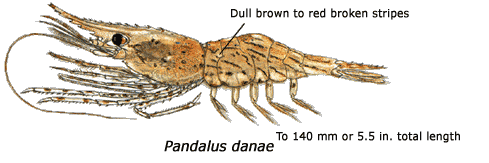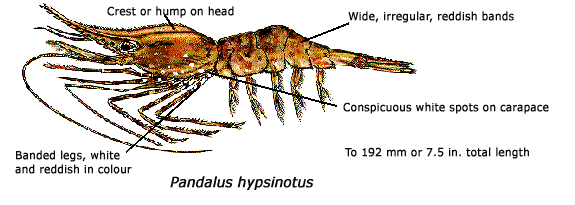Shrimp and prawn biology
Prawn or spot shrimp (Pandalus platyceros)

Illustration by A. Denbigh
This species is the largest of the local shrimps with large females exceeding 23 cm in total length. Its body colour is usually reddish brown or tan, with white horizontal bars on the carapace, and distinctive white spots on the first and fifth abdominal segments.
At times, juveniles have been observed on muddy bottoms, but adults normally live in rocky crevices and under boulders. The prawn ranges throughout the northern Pacific from Unalaska to San Diego, California, and from the Sea of Japan to Korea Strait. Commercial trap fishing is carried on all along the British Columbia coast. The most popular sport trapping grounds are located in the Strait of Georgia.
The prawn is a male during its second and third years, then changes sex in the third or fourth year. Eggs are found on females from October to March.
Coonstripe or dock shrimp (Pandalus danae)

Illustration by A. Denbigh
A female coonstripe shrimp may reach a total length of 14 cm but the usual length is 7.5 to 10 cm. The irregular striping of brown and red on the abdomen gave rise to the one common name; the other followed from this shrimp's habit of living at times around docks. Otherwise, it inhabits sand or gravel bottoms, usually where a rapid tidal current flows.
The coonstripe ranges from Sitka, Alaska, to near San Diego, and a continuing productive trap fishery is carried out in Sooke Harbour. Through the nights of late summer and early fall near Sidney and elsewhere around the Saanich Peninsula, sportsmen pursue the coonstripe with baited ring traps and dip nets.
Shrimps of this species function as males during the first and second years, and as females in their second and third years. Some individuals mature first as females never functioning as males. Females with eggs may be found year round, but the main season is from November to April.
Humpback or king shrimp (Pandalus hypsinotus)

Illustration by A. Denbigh
The humpback ordinarily is 10 to 12.5 cm in length, but large females may reach 17.5 cm. This shrimp is called humpback because of the arched shape of the carapace. The conspicuous mottling on the abdomen is also distinctive.
The humpback occurs in the Bering Sea, from the Aleutian Islands to Puget Sound, and in the Ohkotsk Sea as far south as the Korea Strait. In terms of the shrimp fishery, it is of minor importance, appearing in trawl catches along with pink shrimps in Burrard Inlet and Stuart Channel, and as the main by catch from prawn trapping in central and northern mainland inlets. There is a small directed fishery in Prince Rupert Harbour. However, the humpback is held to be the finest eating shrimp of all six species.
This species attains maturity as a male, and in varying proportions as a female, in the second year, and becomes a female during the third year. Subsequent survival into the fourth year is very low. Female shrimps carry eggs from November to April.
Smooth pink or ocean pink shrimp (Pandalus jordani)

Illustration by A. Denbigh
The smooth pink shrimp is very similar in size, colour, and body characteristics to the pink shrimp, but it lacks that prominent spine or lobe on the curve of the abdomen.
The recorded distribution of this species ranges from Unalaska to near San Diego, but exploitable populations occur only between Queen Charlotte Sound and northern California. Local trawling grounds lie along the continental shelf off Tofino and Nootka Sound, in Barkley Sound, and along the east coast of Vancouver Island. This shrimp, now in second place commercially, was the most valuable shrimp species landed from 1960 to 1978.
Maturation as a male occurs during the second year, with sex change taking place in the following year. In the Strait of Georgia, it is known that as many as 40 per cent of an age group may mature first as females. The egg-bearing period extends from November to April.
Pink shrimp - Spiny (Pandalus borealis)

Illustration by A. Denbigh
The length of this shrimp is normally 7.5 to 10 cm, but larger individuals may reach as much as 15 cm. The pink shrimp and the smooth pink are similar in colouration, with both species lacking bands or blotches on the legs. The main distinguishing feature of the pink is the sharp spine or lobe that points backwards from the curve of the abdomen.
The pink shrimp is a wide-ranging species, known in the Chukchi and Bering seas, from Unalaska in the Aleutian Islands to the Columbia River mouth, along the Asian coast from Kamchatka to Korea, from the Barents to the North Sea, and from western Greenland to the Gulf of Maine. In British Columbia, it occurs chiefly in mainland inlets, probably because water temperatures tend to be lower there. Trawl catches of the species are made on mud bottoms at 54 to 90 m in Burrard Inlet, Howe Sound, and Chatham Sound.
The pink is an active male in the second year and becomes a female during the third year. It lives at least three years. In Burrard Inlet, about half the individuals in an age group may mature exclusively as females. The eggbearing period lasts from November to April.
Sidestripe or giant shrimp (Pandalopsis dispar)

Illustration by A. Denbigh
In size, the sidestripe is second only to the prawn, with large females reaching 20 cm in length. The long antennules and striped abdomen clearly distinguish this shrimp from other species.
The sidestripe occurs in the northeastern Pacific Ocean from the Bering Sea to the Oregon coast. In British Columbia, it is caught by trawl in English Bay, Howe Sound, Stuart Channel, Barkley Sound and Chatham Sound, but it rarely enters baited traps. It is generally found on muddy bottoms, at depths of 90 to 201 m.
Maturity as a male is attained during this shrimp's second year. Sex change occurs in the third year, with relatively few females appearing to survive into the fourth year. In the Strait of Georgia, females carry eggs from October to March.
Life stages of the prawn
| Description | Illustration |
|---|---|
| Larvae hatch in March - April in adult habitat of 70 - 90 m. Five larval stages over 2 - 3 months. Larvae settle in summer. found in shallower regions < 54 m. | 
|
| 12 months; 21 mm carapace length (c/l); 6.5 grams (g). |  |
| Back on adult grounds. 18 to 24 months. Mature and function as males. 24 months; 33 mm c/l; 23 g |  |
| 24 to 30 months transforming from males to females (transition phase). |  |
| Females by 36 months. Most growth occurs in May/June, then energy is directed to reproductive growth. 48 months; 38 mm c/l; 35 g.; Eggs carried (2000 to 4000) by female for about 5 months in the period September to April. After spawning high mortality. Few second spawners. |  |
- Date modified: